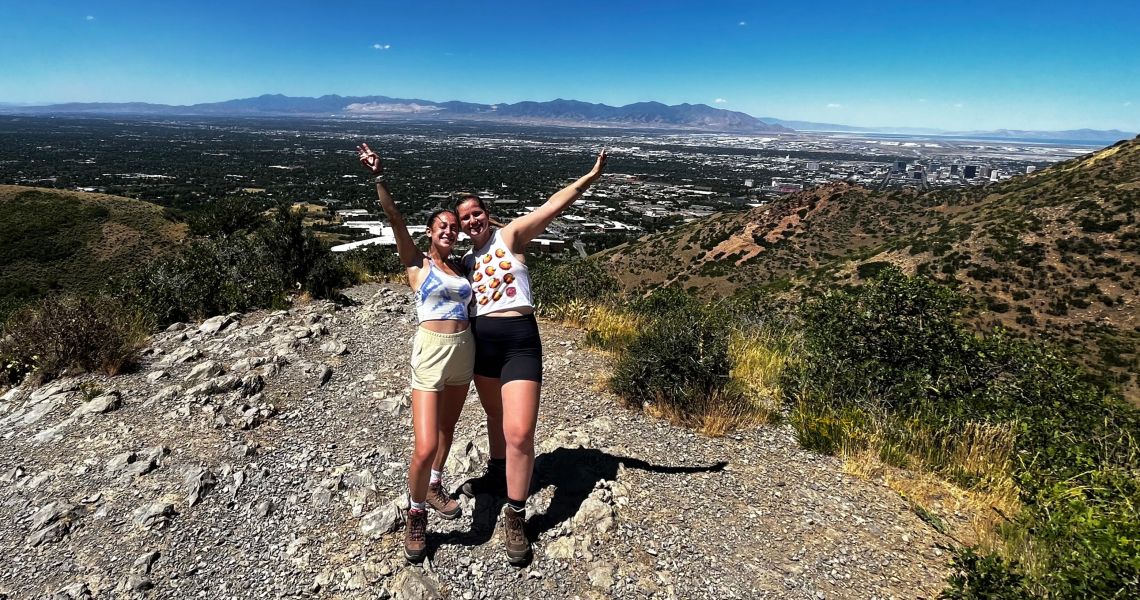If an opportunity came along to travel across the country for the summer with your best friend, and practice every day in your dream physical therapy clinic, would you take it? For two GW DPT third-year students, there was only one correct answer: absolutely!
Rachel Srolovitz and Ashley Warren, both members of the DPT Class of ‘23, spent their summer at The University of Utah Craig H. Neilsen Rehabilitation Hospital in Salt Lake City for the first of three, full-time clinical experiences in their final year of the DPT program.
“Committing to the placement was stressful because it was first-come, first-served,” said Warren. “We confirmed our spots a year before we actually started, but it was worth it. It made a big difference to go with a friend; I don’t think I could have done it by myself.”
Srolovitz, who was placed in the Spinal Cord Injury Unit, enjoyed both seeing patients progress and playing a part in their rehabilitation. “It was cool to see patients, who came in paralyzed or unable to move their legs, eventually be able to walk with assistance,” she said.
Srolovitz chose to pursue Spinal Cord Injury Unit based on a faculty recommendation and a keen interest for inpatient neurological rehabilitation. “I like the idea of being able to work with the same patients every day,” said Srolovitz. “We had the chance to build good relationships with the patients, and it was amazing to see the amount of progress they made from admission to discharge.”
On the Complex Medical Unit, Warren’s caseload consisted of patients diagnosed with strokes, spinal cord injuries, complications resulting from long-covid, and those patients who had undergone major surgeries such as tumor resections, amputations, and organ transplants.
“The thing that stood out to me most was all of the available technology. There aren’t many places in the country that have all of those things in one place,” said Warren. The wealth of equipment, she added, included the ZeroG Gait and Balance System, Erigo tilt table, an aquatic treadmill, and a virtual reality treadmill (C-Mill) that allows patients to negotiate a variety of tasks and obstacles with the support of an overhead harness. “The C-Mill was really helpful for patients who have gotten used to compensating for their impaired gait mechanics,” she added. “The treadmill has cameras, can measure weight-bearing forces, and provide biofeedback to patients with each step.”
Another facet of the experience that appealed to both Srolovitz and Warren was the clinic’s involvement with adaptive sports, specifically the Technology Recreation Access Independence Lifestyle Sports (TRAILS) program. The program, affiliated with the hospital, was designed for patients with spinal cord injuries and featured a host of outdoor activities such biking, kayaking, sailing, and, in the winter, skiing.
“TRAILS was a great resource for our patients because it gave them the opportunity to get out of the hospital, spend time with their families, and even continue the program through outpatient services,” said Srolovitz.
Warren credited the GW’s DPT program depth and breadth of the curriculum for preparing them for this experience.
“I was surprised how much musculoskeletal content I used in the treatment of individuals with neurologic dysfunction, and how much I used aerobic training principles with long-covid patients who were deconditioned from being in hospital for months,” said Warren.
Srolovitz pointed to the extensive neurologic curriculum, which incorporated practice with transfers and interventions for patients with spinal cord injuries. The placement, she said, helped solidify the concepts and techniques she learned. “I feel like you don't really understand things until you practice them in person.”
“It’s helpful, especially as a first experience, to get your hands on as many people as possible and have exposure to many types of patients,” added Warren.
Srolovitz believes her experience at Craig H. Neilsen Rehabilitation Hospital will have a significant impact on her future career. “I’m grateful for this experience because I got to learn a lot from experienced PTs, explore a new place, practice with state-of-the-art equipment at a newer hospital, and build relationships with patients,” she explained.
Warren’s advice for students beginning clinical rotations: “Don’t be afraid to pursue something, whether it's a whole clinical experience or specific experiences within a rotation or at a site. Do all of the things, and don't look back.”
